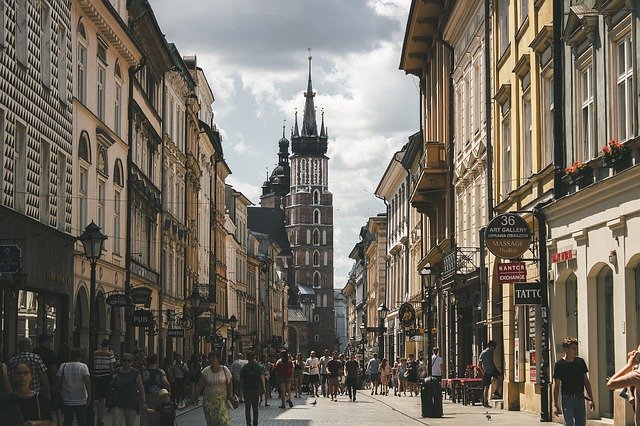By Tim Lambert
Early Krakow
According to legend Cracow was founded by a hero called Krak who killed a dragon by feeding it animal skins filled with sulfur. In reality, Krakow was a thriving settlement and a center of trade by the 10th century. Krakow was first mentioned in 965 by a Spanish merchant who described a flourishing town on important trade routes.
By 1000 Krakow had a bishop. Then in 1028, Krakow was made the capital of Poland. However, in 1079 Stanislaus the bishop of Krakow was killed by the king. He later became the patron saint of Poland.
In 1241 disaster struck when the Mongols invaded Poland. They sacked Krakow. However, Krakow was rebuilt and in 1257 Boleslaw the Shy gave the town a charter (a document granting the townspeople certain rights). From then on Krakow had self-government.
From 1320 Polish kings were crowned in Krakow. Meanwhile, the present Wawel Cathedral was built in Krakow in the years 1320 to 1364. The Cloth Hall was also built in the 14th century. (It was rebuilt after a fire in 1555). In 1364 Kazimierz the Great founded Krakow Academy. Then in 1499, the Great Barbican in Krakow was built.
Meanwhile, by the 14th century, there was a large Jewish community in Krakow. n In the 15th century a style of shoes with long pointed shoes was popular in Europe. They were called crakows because they were believed to have originated in Krakow.
In the years 1491 to 1495 the great Polish astronomer Nicolaus Copernicus studied at Krakow. In the 16th century, Krakow continued to flourish. Wawel Royal Castle was rebuilt as a splendid palace.
However, Krakow ceased to be the capital of Poland in all but name after 1596. From that date, the kings resided in Warsaw. Krakow continued to be the official capital till 1791 but in reality, Warsaw was the effective capital.
Although Krakow lost some of its importance in the 17th century and 18th century St Anne’s Church was rebuilt in the years 1689-1705.
In the late 18th century Russia, Prussia, and Austria divided Poland up between themselves. In 1795 Krakow was taken by Austria.
However, in 1796 Czartoryski Museum was founded by Princess Izabela.
Modern Krakow
In 1809 during the Napoleonic Wars Krakow became part of the Duchy of Warsaw. In 1815 following the defeat of Napoleon Krakow was made its own state. It was called the Republic of Krakow.
However, in 1846 there was a rebellion in Krakow in an attempt to establish an independent Poland. The rebellion was crushed and afterward, Krakow was annexed. It became the Grand Duchy of Krakow.
Meanwhile, in the early 18th century most of the fortifications around Krakow were demolished. Fortunately, Krakow Barbican was preserved. In 1850 Krakow was severely damaged by a fire. Nevertheless, in the late 19th century Krakow flourished. Meanwhile, Krakow Railway Station was built in 1847.
Meanwhile, Krakow Scientific Society was founded in 1816. Krakow Archaeological Museum was founded in 1850 and the National Museum in Krakow opened in 1879. Juliusz Slowacki Theatre was built in 1893.
Krakowski Park opened in 1885 and Jordan Park opened in 1889.
From 1882 horse-drawn trams ran in the streets of Krakow. From 1901 they were replaced by electric trams. Then in 1912, the first cinema in Krakow opened.
In 1918 Poland became an independent nation again. However, in 1939 the Germans invaded Poland. In 1939 about 65,000 Jews were living in Krakow. During the Second World War, most of the Jewish population of Krakow was deported and killed.
Unfortunately, after the war, Nazi tyranny was replaced by Communism. However, most of the old buildings in Krakow survived the war intact.
The Nowa Huta Steelworks was built in the early 1950s. The Polish Aviation Museum opened in 1964. Then in 1978 Krakow old town was declared a world heritage site by UNESCO.
Following the collapse of Communism Krakow is again flourishing. Krakow Technology Park opened in 1998. Today tourism in Krakow is thriving. Modern Krakow also has shopping malls, Krakow Plaza, which opened in 2002, Galeria Kazimierz, which opened in 2005, Galeria Krakowska, which opened in 2006 and Bonarka, which opened in 2009.

Meanwhile, Eros Bendato (a sculpture of a giant head) was moved to Krakow in 2003. Krakow Opera House opened in 2008. In 2024 Krakow had a population of 769,000.